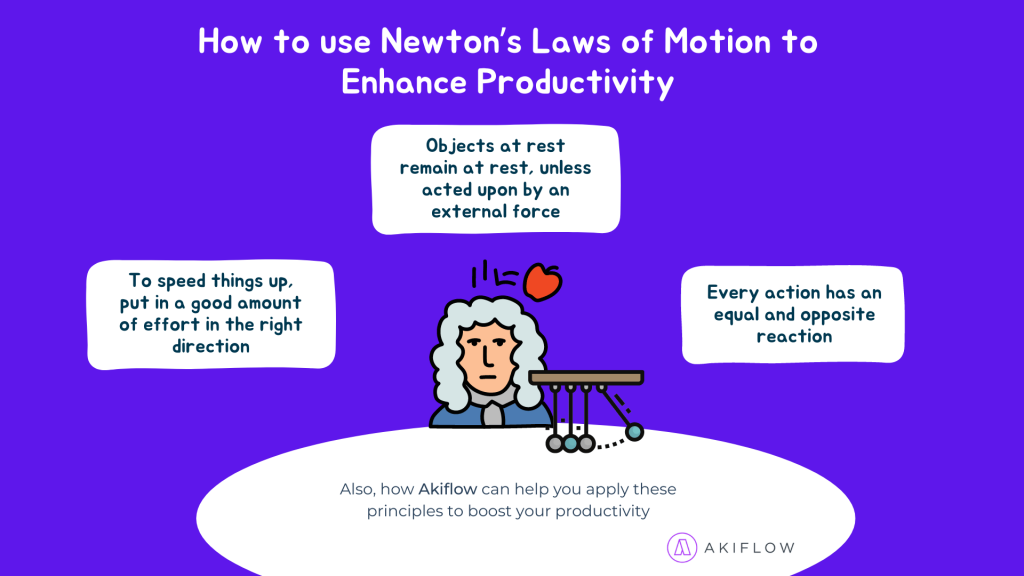Introduction
One of Newton’s laws of motion, in layman’s terms, says that “Objects at rest tend to stay at rest unless an external force is exerted on them.” Those of us who have dealt with procrastination and seen it hamper our productivity know this all too well.
Productivity is the holy grail of success. In our personal and professional lives, we’re constantly trying to get more done in less time. But how can we do that? What are the laws of productivity? What principles can we apply to become more efficient and effective? In this article, we’ll explore the concept of productivity through the lens of physics, specifically Newton’s laws of motion. We’ll examine how these laws can be applied to productivity and provide practical tips to help you do more in less time. Before diving into how Newton’s laws of motion can be applied to productivity, let’s first take a quick look at these laws.

Newton’s Laws of Motion
Sir Isaac Newton (1642-1727) was an English physicist, mathematician, and astronomer widely regarded as one of the most influential scientists in history. In 1666, he developed the theories of gravitation when he was only 23 years old. After that, he presented his three laws of motion in his book, “Principia Mathematica Philosophiae Naturalis”, first published in 1687. These laws are still widely used today to explain the behavior of objects in motion, from planets and stars in space to the movement of vehicles and machinery on Earth. They are considered to be some of the most fundamental principles of physics and have profoundly impacted our understanding of the natural world. These are fundamental principles that describe the behavior of objects in motion. The laws are:
- The First Law or The Law of Inertia: An object at rest will remain at rest, and an object in motion will remain in motion at a constant velocity unless acted upon by an external force.
- The Second Law or The Law of Acceleration: F = ma (i.e., force equals mass times acceleration). The vector sum of forces exerted on an object equals the object’s mass multiplied by its acceleration vector.
- The Third Law or The Law of Action-Reaction: For each and every action in nature, there is an equal and opposite reaction. In other words, whenever an object exerts any force on another object, the other object exerts an equal yet opposing force on the first object.
Now that we have an elementary understanding of Newton’s laws of motion let’s explore how these laws can be applied to productivity.
The First Law of Productivity: The Law of Inertia
First Law of Motion: An object at rest will remain at rest, and an object in motion will remain in motion at a constant velocity unless acted upon by an external force.
The first law of productivity is the law of inertia. This law states that starting a task is hard, but once you do, it becomes easier to keep going.
Here are some tips that could help you overcome the law of inertia and get started on a task:
- Conquer procrastination: To overcome procrastination, use the 2-minute rule, i.e., find a way to start your task in less than two minutes. For instance, if your goal is to become fitter, then doing a simple and quick task, such as putting on your running shoes, can help you align your mindset towards stepping out for a run.
- Break tasks into smaller, more manageable chunks: When a task seems overwhelming, it can be difficult to get started. Breaking it into smaller, more manageable chunks can make it seem less daunting and help you get started.
- Use the Pomodoro Technique: This time management method involves working for a given amount of time (typically 25 minutes) and then taking a short break. This technique can help you overcome the law of inertia by making it easier to get started.
The Second Law of Productivity: The Law of Acceleration
The Second Law or The Law of Acceleration: F = ma (i.e., force equals mass times acceleration). The vector sum of forces exerted on an object equals the object’s mass multiplied by its acceleration vector.
The second law of productivity is the law of acceleration. The second law states that F = ma, where F or force is a vector, i.e., it involves both magnitude (the amount of work or effort put in) and direction (where the work or effort was focussed). While working hard is essential, directing that effort toward the right things is equally important. In other words, if you want to accelerate an activity or outcome, you need to apply a good deal of effort in the right direction.
For instance, by focusing your efforts in one direction, you might achieve remarkable results, while dispersing them in multiple directions could lead to little progress. By understanding the F=ma equation and how it relates to productivity, you can make more informed decisions about where to channel your efforts and maximize your chances of success.
To apply the law of acceleration to productivity, try the following tips:
- Prioritize tasks: Prioritizing can help you determine which tasks are most important and which can wait. It can help you allocate your time and energy more effectively.
- Focus on high-value tasks: High-value tasks are tasks that have a high impact on your goals or objectives. You can make the most of your given time and effort by focusing on these tasks.
- Use the right tools and technology: Several tools and technologies can help you be more productive, such as Akiflow, the ultimate time-blocking platform. Akiflow presents your tasks and calendar in a single view, automatically collects your tasks from multiple platforms in one place, and helps you turn your emails into tasks and more. Start your free trial of Akiflow today and discover how Akiflow can boost your productivity to a whole new level.

- Put in the work and effort: Of course, there is no alternative to putting in the hours of hard work to achieve spectacular results. Roll up your sleeves and dive in.
The Third Law of Productivity: The Law of Action and Reaction
Third Law of Motion: For each action in nature, an equal and opposite reaction exists. In other words, whenever an object exerts any force on another object, the other object exerts an equal yet opposing force on the first object.
The third law of productivity is the law of action and reaction. Your average levels of productivity and efficiency are most likely a balance of the productive and unproductive forces around you. Productive forces push you toward your goals, while unproductive forces hold you back.
To apply the law of action and reaction to productivity, try doing the following in conjunction:
- Increase productive forces, such as good time management, motivation, supportive relationships, etc. The productive forces in our lives propel us forward, giving us the energy and focus we need to accomplish our goals.
- Eliminate unproductive forces, such as stress, lack of sleep, procrastination, distractions, etc. Unproductive forces in our lives hold us back, drain our energy and distract us from what’s important. You can eliminate them by meditating, exercising, and using time management and time-blocking tools such as Akiflow.
Conclusion
Productivity is a complex and multifaceted concept. There is no one-size-fits-all solution to becoming more productive. However, by applying the principles of physics, specifically Newton’s laws of motion, we can gain a better understanding of productivity and identify strategies for improving it. By overcoming the law of inertia, applying the law of acceleration, and understanding the law of action and reaction, we can become more efficient, effective, and successful. With a little effort and intentionality, we can tip the scales in favour of productivity and efficiency.
PS
The inspiration for the analogy involving Newton’s laws and productivity goes to James Clear, author of the NY best-seller ‘Atomic Habits’.

How To Manage Time Blindness
Explore five effective tactics to conquer time blindness, a common challenge affecting time perception and management. Learn practical strategies for enhancing productivity and achieving a more organized, time-conscious lifestyle.

Dawn of Success: Crafting Effective Morning Rituals
Explore the transformative power of morning rituals in ‘Dawn of Success., and discover how effective morning routines can boost productivity, enhance well-being, and set the stage for daily achievements

12 Best Google Calendar Alternatives
Explore the top 12 Google Calendar alternatives to boost your productivity and streamline your scheduling. Check the diverse options catering to different needs and find the perfect calendar app for you.

